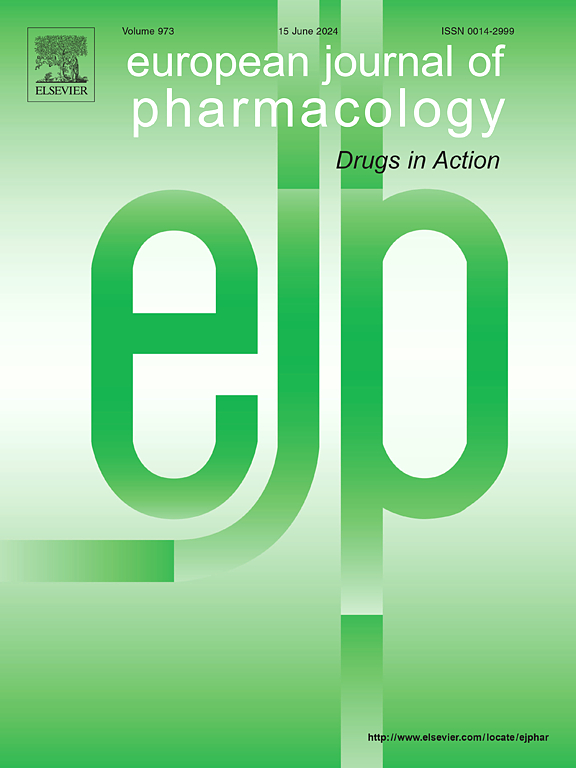Oxyberberine撤销雌性Sprague-Dawley大鼠来曲唑诱导的多囊卵巢综合征和抑郁样行为
IF 4.2
3区 医学
Q1 PHARMACOLOGY & PHARMACY
引用次数: 0
摘要
多囊卵巢综合征(PCOS)是一种常见于育龄妇女的内分泌疾病,对人的精神健康也有负面影响。在此,我们研究了oxyberberine对雌性Sprague-Dawley大鼠PCOS和抑郁样表型的影响。为了产生PCOS和抑郁样表型,给大鼠注射来曲唑(1mg /kg/天,持续21天),并暴露于14天的慢性不可预测的轻度应激(CUMS)。我们从其天然母体植物成分小檗碱合成了oxyberberine。接受来曲唑+ CUMS暴露的大鼠在阴道涂片试验中显示中性粒细胞数量增加,表明pcos样表型(即发情期中断)。此外,这些大鼠在蔗糖偏好测试、强迫游泳测试和升高的正迷宫测试中也表现出快感缺乏、抑郁和焦虑样行为。以50和100 mg/kg剂量口服oxyberine 21天,逆转来曲唑+ CUMS在大鼠中产生的扰动。试验组在野外测试中的总体探索行为没有受到影响。Oxyberberine处理也恢复了卵巢和子宫的器官重量指数和卵巢的卵泡发育。采用液相色谱-质谱联用法测定全身和子宫中羟小檗碱含量分别为0.17 ~ 0.80 ng/mL和1.03 ~ 3.62 ng/mL。Oxyberberine还能正向调节肠、脾过氧化氢酶和丙二醛水平、体循环睾酮和黄体生成素水平以及卵巢中CYP17A1、CYP19A1和SHBG表达。这些结果表明,oxyberberine通过调节卵巢中睾酮激素、CYP17A1、CYP19A1和SHBG酶的表达来改善PCOS和抑郁样表型。本文章由计算机程序翻译,如有差异,请以英文原文为准。

Oxyberberine revokes letrozole-induced polycystic ovarian syndrome and depression-like behavior in female Sprague-Dawley rats
Polycystic ovarian syndrome (PCOS) is a prevalent endocrine disorder in reproductive-age women, which also negatively perturbs person's psychiatric health. Herein, we investigated the effect of oxyberberine on PCOS- and depression-like phenotypes in female Sprague-Dawley rats. To generate PCOS- and depression-like phenotypes, rats were injected with letrozole (1 mg/kg/day for 21 days) and exposed to 14 days of chronic-unpredictable mild stress (CUMS). We synthesized oxyberberine from its natural parent phytoconstituent i.e., berberine. Rats underwent letrozole + CUMS exposure displayed an increased number of neutrophils in a vaginal smear test indicating a PCOS-like phenotype (i.e., disrupted estrus cycle). Moreover, these rats also showed anhedonia-, depression-, and anxiety-like behaviors in the sucrose-preference test, forced-swimming test, and elevated plus-maze test. Peroral administration of oxyberberine for 21 days, at 50 and 100 mg/kg doses, reversed letrozole + CUMS generated perturbations in rats. The total exploratory behavior in the open field test remained unaffected across the treatment groups. Oxyberberine treatment also restored the organ-weight index of the ovary and uterus and follicular development of the ovary. Systemic and uterine levels of oxyberberine were found to be 0.17–0.80 ng/mL and 1.03–3.62 ng/mL, respectively measured using a liquid chromatography-mass spectrometry assay. Oxyberberine also positively modulated the levels of catalase and malondialdehyde in intestine and spleen, and testosterone and luteinizing hormones in the systematic circulation and CYP17A1, CYP19A1, and SHBG expression in the ovary. These results suggest that oxyberberine improves PCOS- and depression-like phenotypes in rats by modulating testosterone hormone, CYP17A1, CYP19A1, and SHBG enzyme expression in the ovary.
求助全文
通过发布文献求助,成功后即可免费获取论文全文。
去求助
来源期刊
CiteScore
9.00
自引率
0.00%
发文量
572
审稿时长
34 days
期刊介绍:
The European Journal of Pharmacology publishes research papers covering all aspects of experimental pharmacology with focus on the mechanism of action of structurally identified compounds affecting biological systems.
The scope includes:
Behavioural pharmacology
Neuropharmacology and analgesia
Cardiovascular pharmacology
Pulmonary, gastrointestinal and urogenital pharmacology
Endocrine pharmacology
Immunopharmacology and inflammation
Molecular and cellular pharmacology
Regenerative pharmacology
Biologicals and biotherapeutics
Translational pharmacology
Nutriceutical pharmacology.

 求助内容:
求助内容: 应助结果提醒方式:
应助结果提醒方式:


